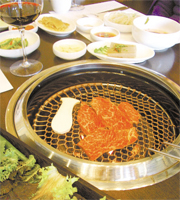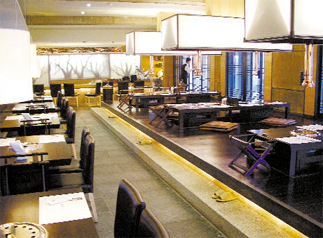Korean passion for home-grown meat is tradition

The top-grade sirloin on the grill served with vegetables, side dishes and red wine. By In? Cho
In sleek restaurants like Byeokjae Galbi (02-2058-3535), Casa Muro (02-3444-3554) and Hanok, trendsetters can be seen grilling the choicest hanwoo cuts with European wine.
Kim Binna, the executive director of the Il Mare Co., Ltd. franchise restaurant company, thinks Korea’s top-grade beef should be exported for worldly epicures to enjoy. “In most upscale Korean restaurants in New York or London the taste is not Korean,” Kim said, adding that Hanok is just employing such a plan. To start with she worked on supplying A+ grade hanwoo for up to 80 diners per day. Even with an improved computer grading system that tracks breeding technology, the quantity of such beef is limited.
Like Japanese wagyu, hanwoo is an an appellation known among beef industry professionals worldwide. Hanwoo fans know the cream of the crop comes from Gangwon and Jeolla provinces. Kim says Hanok’s beef comes from the south.
The restaurant maintains the theme of natural elements found in hanok homes, complete with wooden beams, warm floors and shadows of trees. Charcoal grills mounted on tables come with built-in ventilators, which suck the cooking odors away.
A seven-course lunch menu (40,000 won per person, or about $45) featuring a plate of seared beef and two types of grilled meat (fresh rib meat and marinated rib meat) impressed my tablemates.

Seared beef dishes inspired by Korean traditional cold cuts.
The only disappointment was the iceberg lettuce salad. It was extremely fresh, but I beg all Korean restaurants to please stop serving the salad because it was never a part of Korean cuisine and there are plenty of delicious plants in Korea. Another fusion dish is seared beef, inspired by Korean cold dishes, which aims to impress non-Korean diners. A nice try.
After five courses over a bottle of Korean raspberry wine (20,000 won), my tablemates and I, who swore we would only taste the soup, held onto the bowl of naengmyeon, or buckwheat noodles in chilled soup, until nothing was left.
Aficionados of hanwoo can have a serial, orthodox tasting session at Hanok. Over a glass of house wine, the Chilean red, 2006 Campero Merlot (8,000 won), we started with 150 grams of fresh kkotdeungsim (48,000 won), or gorgeously marbled sirloin, named after flowers, because of elaborate marbling.
Our waitress was overly attentive. She watched the cooking and vigorously cut the slab with scissors. When she shouted ― “The meat’s ready, eat right now!” ― each morsel was sizzling brown on the outside and glowing pink inside. To taste such an exquisite morsel, it was best to just dip it lightly in sea salt. The taste was what caused all the hanwoo craze.
We also sampled 130 grams of chadolbaegi, or brisket (25,000 won). This round, fatty part of brisket is cut paper-thin, and it is chewy. It is the white fat that shrivels along the tender brown meat that has captured the palate of local epicures. The Hanok meat certainly wowed my tablemates, who buy top-grade brisket from a few select butchers.
Now comes the Hanok Special ―the fresh rib meat, A++ grade, from three-year-old female cows. One serving, 260 grams, costs a hefty 63,000 won.
With each chew, I felt a burst of juicy pleasure in my mouth that turned into a delirious whole-body sensation, which lingered long after the morsel had gone from my tongue. The faintest fragrance of oil, herb, spice or even a non-hanwoo thought, would have interfered with our ascent to the nirvana of taste at this temple of hanwoo.
Did the background music have anything to do with our culinary trip? We heard a dreamy traditional Korean zither playing modernized pieces from the Goryeo Dynasty.
A boiling pot of hearty soybean stew brought us back to earth, but we were not quite the same.
How to cook

The interior of the restaurant.
To add festivity and enjoy the fresh taste, chefs at home can use an electric saucepan or cooker at the table. To match the Korean stew, he recommends German Riesling or Australian Chardonnay or light Chianti.
Ingredients for the special Hanok broth
600 grams of water
200 grams of radishes
100 grams of onion
100 grams of the white stems of green onion
100 grams of Korean pear
7 cloves of garlic
100 grams of ginger
200 grams of young cabbage
100 grams of konbu
60 grams of soy sauce
20 grams of sugar
about 10 grams each of four fresh mushrooms (ear mushroom, oyster mushroom, Boletus mushroom and enokitake mushroom)
Place all the ingredients into a saucepan and boil for 45 minutes on a medium fire. Strain for the clear broth.
Ingredients for the stew for 4 servings
2 cups of the Hanok broth
70 grams of wet glass noodles
140 grams of Chinese cabbage
50 grams of carrots
50 grams of green onions
60 grams each of four mushrooms (ear mushroom, oyster mushroom, Boletus mushroom and enokitake mushroom)
4 sesame leaves
400 grams of fresh hanwoo bulgogi beef, or sirloin, sliced with 1.5 millimeter thickness
1.Wash all the fresh vegetables, cut them into edible sizes and place them in a large plate.
2.Dry ingredients such as glass noodles and ear mushroom should be cooked. Put a bundle of dry glass noodles into a pot of boiling water and cook for 2-3 minutes until the noodles are clear. Strain. Soak ear mushrooms in hot water for 5-10 minutes until mushrooms are tender. Strain.
3.Place the fresh sliced beef in a large plate.
3.At the table, bring the broth to boil on a high fire.
4.When the broth boils, bring the fire down to medium.
5.Add the vegetables and the noodles.
6.When the broth boils again, add the beef and cook lightly.
7.Serve immediately.
Hanok
English: Spoken, on the menu.
Tel: 02-3445-7857
Hours: 11 a.m.-3 p.m.; 5-midnight daily
Location: Behind the Prada store in Cheongdam-dong
Dress code: Business or smart casual
Parking: Valet
By Ines cho Staff Writer [inescho@joongang.co.kr]










with the Korea JoongAng Daily
To write comments, please log in to one of the accounts.
Standards Board Policy (0/250자)